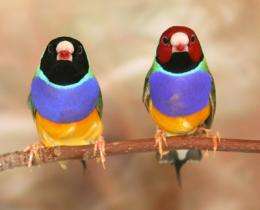Sons or daughters? Female finches use head colour to decide

(PhysOrg.com) -- Researchers studying the behaviour of the stunningly coloured Gouldian finch have made an exciting discovery - females of the species deliberately overproduce sons when breeding with a male of a different head colour.
The two-year study, funded by the Australian Research Council, has produced the clearest evidence yet to show that birds are capable of deliberately biasing the gender of their eggs.
The findings have been published today in the leading international journal Science.
Macquarie University biologists made the discovery following experiments with a captive population of Gouldian finches in the Hunter Valley. Gouldian finches are unique in that they can have either black or red heads, yet are still regarded part of the same species.
Two hundred female finches bred with a male of the same head colour and a male of a different head colour. Then, the researchers tested the effects by dyeing the heads of the male birds.
Through their experiments the researchers established that the birds with the red heads and the birds with the black heads were genetically incompatible. When females were forced to mate with an incompatible male, or were tricked into thinking they were, they biased the gender of their eggs to produce more sons.
Sons resulting from genetically incompatible pairings have a much better chance of survival than daughters.
"Over eighty per cent of Gouldian finch chicks will be male if the father has a different coloured head to the female," said lead author Dr Sarah Pryke.
"There's no chemical or genetic interaction between the parents at work. Change the colour of the male's head with dye and the sex ratio changes.
"Gouldian finches wear their genes on their head, so it's relatively easy for a female to simply assess the genetic suitability of the male."
The discovery suggests that across the animal kingdom females can have much more influence on the sex of their offspring than was previously thought possible.
"This shows that species are very complex and that genetic incompatibility between a male and female, even within a species, can be a major driving force in the evolution of behaviour," Pryke said.
This work is also a reminder of the importance of endangered species for science as well as the environment. The Gouldian finch is one of Australia's most endangered birds, with only a few thousand remaining in the wild.
"The study highlights just how little we know about this iconic Australian species," said Mike Fidler, Director of the Save The Gouldian Fund.
"This discovery has important implications for how we conserve and ultimately save this finch."
Professor Ben Sheldon, of the University of Oxford's Edward Grey Institute, said the results demonstrated "hitherto unsuspected degrees of control over reproductive investment by female birds".
"This work opens new possibilities in unravelling the mechanisms behind these striking behaviours, something which has up to now remained an unsolved mystery," Sheldon said.
Sarah Pryke and Simon Griffith are ARC Research Fellows with the Department of Brain Behaviour and Evolution at Macquarie University. Animal behaviour is one of 19 Concentrations of Research Excellence (COREs) at Macquarie.
Provided by Macquarie University














